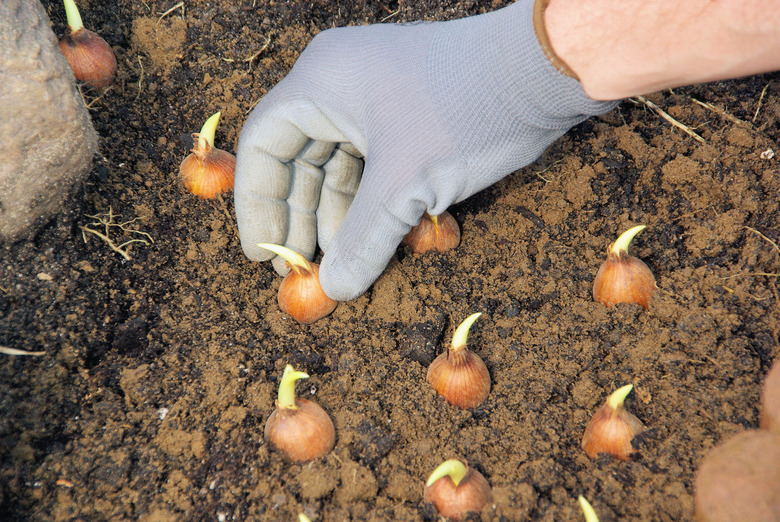The Best Time To Plant Tulip Bulbs In Wisconsin
Wisconsin is gifted with Great Lakes on two sides, North America's longest river on another and the contrast of land left by glaciers, flat "driftless" areas and Uplands where rivers dig mini-canyons begun in prehistory. For tulips (Tulipa ssp.), its cold, snowy winter chills can make for spectacular springs. For spring bloom, plant tulips in Wisconsin six to eight weeks before the first frosts of autumn.
Wisconsin's Continental Climate
Wisconsin gardeners live in U.S. Department of Agriculture plant hardiness zones 3b through 5b. Lowest winter temperatures range from 35 below zero Fahrenheit in the northwest to 15 below along the shores of Lake Michigan. Summer rainfall varies, west to east, from 34 to 28 inches, contributing to a cool, wet continental climate.
Southern Wisconsin's first frost comes about two weeks later than it does in the northwest interior of the state, but the southern part of the state also often enjoys several weeks of mild weather before winter sets in. Since fall planting benefits root development rather than top growth, ground frost might end tulip planting time in early September in the north. In the longer autumn near Lake Michigan in the south, bulbs might be safely planted until late October.
Early Preparation
Planting spring bulbs, say the garden calendars, is the last pleasant task of the gardener before retiring for the winter, but Wisconsin's raw and rainy autumns preclude procrastination. Take a couple of sunny days in September to find the sunniest place in the garden for your tulips. Wait to plant, though, because planting while soil is still warm encourages tender top growth.
Much of Wisconsin's soil is well-drained loam, but some contains significant amounts of clay. These soils need amendment down to 12 inches with leaf mold or compost, mixed one-to-one with soil. Tulips are hardy in USDA zones 3 through 8, but they are natives of arid continental climates, so they require well-drained soils to avoid bulb rot and diseases bred in wet soils.
Follow Through
Wait until ground temperature drops below 55 degrees Fahrenheit, typically in late September to mid-October, to plant bulbs. Tulip leaves need plenty of space to gather nutrients for next year's bloom, so plant bulbs 8 inches apart. Set bulbs 8 inches deep with at least 4 inches of soil above bulbs to protect them from dehydration as the ground freezes.
The Chicago Botanic Garden recommends sprinkling 5-10-5 granular fertilizer on the surface after backfilling with soil. For bulbs you hope to "perennialize," the University of Wisconsin Extension recommends 10-10-10 fertilizer, scattered after planting and again each fall. Water bulbs deeply after planting and weekly until the first hard freeze only if weather is dry.
Other Dairyland Considerations
Many hybrid tulips are not fully perennial. Dig non-bloomers and check the bottom of the bulb, called the basal plate, for baby "bulblets." Plant these in a sunny patch and when they mature in two to four years, you might have more blooms just like the parent. For dependably perennial bulbs, buy species tulips — Kaufman (Tulipa kaufmanniana) or Greigi (Tulipa greigi) tulips — or heirloom tulips, such as the big old Darwin hybrids.
And a warning: Considering the state's population of squirrels, mice and voles, never use fragrant bone meal to feed tulips, plant them in protective open-ended cans or chicken wire fences or interplant them with distasteful daffodils.
References
- Minnesota and Wisconsin Getting Started Garden Guide: Grow the Best Flowers; Melinda Myers
- Missouri Botanical Garden: Tulipa (Group)
- University of Wisconsin Extension: Climate of Wisconsin
- University of Wisconsin Cooperative Extension: Maps
- Farmer's Almanac: Tulips
- Chicago Botanic Garden: How to Plant Daffodil and Tulip Bulbs
